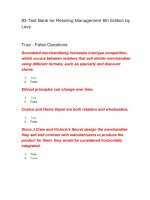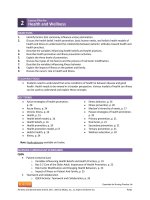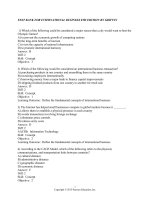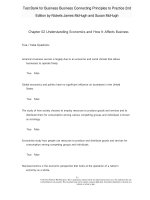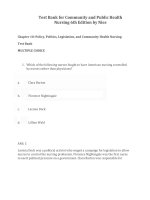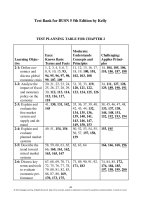Download PDF test bank for essentials for nursing practice 8th edition by potter and perry
Bạn đang xem bản rút gọn của tài liệu. Xem và tải ngay bản đầy đủ của tài liệu tại đây (553.45 KB, 36 trang )
Test Bank for Essentials for Nursing
Practice 8th Edition by Potter and Perry
Chapter 09: Nursing Process
Potter: Essentials for Nursing Practice, 8th Edition
MULTIPLE CHOICE
1. A nurse is collecting data on a patient who is being admitted into
hospice care. The nurse collects data from both the patient and the
family so that a clear picture of the patient status is obtained. The
nurse is currently involved in which step of the nursing process?
a.
Assessment
b.
Implementation
c.
Evaluation
d.
Diagnosing
ANS: A
Assessment is the deliberate and systematic collection of data about a
patient. The data will reveal a patient’s current and past health status,
functional status, and present and past coping patterns. A nursing diagnosis is a
clinical judgment about individual, family, or community responses to actual and
potential health problems or life processes that the nurse is licensed and
competent to treat. Implementation is the performance of nursing interventions
necessary for achieving the goals and expected outcomes of nursing care.
Evaluation is crucial to deciding whether, after interventions have been delivered,
a patient’s condition or well-being improves.
PTS: 1
DIF: Cognitive Level: Applying (Application)
REF: 124
OBJ: Describe each step of the nursing process.
TOP: Nursing Process: Assessment
Care
MSC: NCLEX: Management of
2. The nurse is admitting a patient to the unit and asks the
patient about the health history. The nurse is engaged in
which component of the nursing process?
a.
Evaluation
b.
Diagnosis
c.
Assessment
d.
Planning
ANS: C
The nurse is in the assessment phase. An assessment database includes a
patient’s comprehensive health history, which includes information about a
patient’s physical and developmental status, emotional health, social practices
and resources, goals, values, lifestyle, and expectations about the health care
system. The database also includes physical examination findings and a
summary of results from laboratory and diagnostic testing. A nursing
diagnosis is a clinical judgment about individual, family, or community
responses to actual and potential health problems or life processes that the
nurse is licensed and competent to treat. Evaluation is crucial to deciding
whether, after interventions have been delivered, a patient’s condition or
well-being improves. Planning involves setting priorities, identifying patientcentered goals and expected outcomes, and prescribing nursing interventions.
PTS: 1
DIF: Cognitive Level: Applying (Application)
REF: 124
OBJ: Discuss approaches to data collection in
nursing assessment.
TOP: Nursing Process: Assessment
Care
MSC: NCLEX: Management of
3. A postoperative patient is continuing to have incisional pain. As part
of the nurse’s assessment, the nurse notes that the patient is grimacing
when he or she changes position. The patient’s grimace can be useful
in the assessment and can be described as which of the following?
a.
Cue
b.
Inference
c.
Diagnosis
d.
Health pattern
ANS: A
Grimacing is a cue. A cue is information that a nurse obtains through use of
the senses. An inference is your judgment or interpretation of these cues.
Gordon’s functional health patterns are a type of database format to obtain a
comprehensive assessment. A nursing diagnosis is a clinical judgment about
individual, family, or community responses to actual and potential health
problems or life processes that the nurse is licensed and competent to treat.
PTS: 1
DIF: Cognitive Level: Applying (Application)
REF: 125 data
analysis.
OBJ: Explain the type of conclusions that result from
TOP: Nursing Process: Assessment
Care
MSC: NCLEX: Management of
4. A postoperative patient has denied the need for pain medication. The
nurse has noted that the patient describes the pain as a “1” on a 0 to
10 scale. The nurse also notes that the patient grimaces when he or
she changes position and guards the incision. The nurse believes that
the patient is experiencing pain based on the information gathered
in the assessment. What is this phenomenon known as?
a.
Cue
b.
Inference
c.
Diagnosis
d.
Health pattern
ANS: B
The nurse made a judgment, which is an inference, that the patient is
experiencing pain. An inference is a nurse’s judgment or interpretation of
a cue. A cue is information that you obtain through use of the senses.
Gordon’s functional health patterns are a type of database format to
obtain a comprehensive assessment. A nursing diagnosis is a clinical
judgment about individual, family, or community responses to actual and
potential health problems or life processes that the nurse is licensed and
competent to treat such as impaired tissue perfusion.
PTS: 1
DIF: Cognitive Level: Applying (Application)
REF: 125 data
analysis.
OBJ: Explain the type of conclusions that result from
TOP: Nursing Process: Assessment
Care
MSC: NCLEX: Management of
5. A nurse is collecting data during the assessment of a patient. During the
assessment, the nurse collects both subjective and objective data.
Which information should the nurse consider as subjective data?
a.
Heart rate of 96
b.
Incisional erythema
c.
Emesis of 150 mL
d.
Sharp, burning pain
ANS: D
Sharp, burning pain is subjective. Subjective data are patients’ verbal
descriptions of their health problems. Only patients provide subjective
data. Heart rate, incisions, and emesis are all objective data. Objective
data are observations or measurements of a patient’s health status.
PTS: 1
DIF: Cognitive Level: Analyzing (Analysis)
REF: 126
data.
OBJ: Differentiate between subjective and objective
TOP: Nursing Process: Assessment
Care
MSC: NCLEX: Management of
6. The nurse has just completed an assessment on a patient with a fractured
right femur. Which data will the nurse categorize as objective?
a.
The patient’s toes of right foot are
warm and pink.
b.
The patient reports a dull ache
in the right hip.
c.
The patient says feels tired all the time.
d.
The patient is concerned about
insurance coverage.
ANS: A
Toes pink and warm are objective data. Objective data are observations or
measurements of a patient’s health status. Subjective data are patients’ verbal
descriptions of their health problems. Only patients provide subjective data.
PTS: 1
DIF:
Cognitive Level: Analyzing (Analysis)
REF: 126
data.
OBJ: Differentiate between subjective and objective
TOP: Nursing Process: Assessment
Care
MSC: NCLEX: Management of
7. A student nurse is responsible for assessing a patient, who is
abrupt and requests that the assessment be done later by a
nurse. As the student nurse charts the interaction, which
statement is the best way to document what happened?
a.
Appears to be in pain as
evidenced by grouchy behavior
b.
Behavior is inappropriate, requests
registered nurse do the assessment
c.
States, “I want a registered nurse to
do my assessment”
d.
Is grumpy, registered nurse notified
ANS: C
When a nurse collects objective data, he or she should apply critical
thinking intellectual standards (e.g., clear, precise, and consistent). Nurses
do not include personal interpretive statements. The timely, thorough, and
accurate communication of facts is necessary to ensure continuity and
appropriateness of patient care. If you do not report or record an
assessment finding or problem interpretation, it is lost and unavailable to
anyone else caring for the patient. Grouchy, inappropriate, and grumpy are
personal interpretive statements and should be avoided.
PTS: 1
DIF: Cognitive Level: Analyzing (Analysis)
REF: 126 | 131
OBJ: Explain the relationship between critical thinking and
steps of the nursing process.
TOP: Nursing Process: Implementation MSC: NCLEX:
Management of Care
8. A mother of five children is admitted to the hospital for abdominal pain.
The nurse asks a series of questions before performing a physical
assessment. The patient answers the questions. When asking the patient
some other questions, the patient’s spouse starts to answer. As the
admission process progresses and the nurse gathers subjective data, the
nurse requests that the patient answer the next questions.
What is the rationale for the nurse’s behavior?
a.
The patient is exhibiting confusion.
b.
The spouse is being obnoxious.
c.
The patient is the best source of information.
d.
The spouse is too controlling.
ANS: C
A patient is usually the best source of information. A patient who is alert and
answers questions appropriately provides the most accurate information
about health care needs, lifestyle patterns, present and past illnesses,
perception of symptoms, and changes in activities of daily living. There is no
evidence in the scenario to indicate confusion on the patient’s part or that the
spouse was obnoxious or too controlling. The nurse needs more data before
saying the spouse is obnoxious or controlling.
PTS: 1
DIF: Cognitive Level: Analyzing (Analysis)
REF: 127
OBJ: Discuss approaches to data collection in
nursing assessment.
TOP: Nursing Process: Assessment MSC: NCLEX: Management of
Care
9. A 2-year-old patient is being admitted to the outpatient surgery
for a tonsillectomy. Which will provide the best primary source of
information for what comforts the patient when stressed?
a.
Patient chart
b.
Patient
c.
Parents
d.
Surgeon
ANS: C
Family members and significant others are primary sources of information
for infants, children, critically ill adults, patients with mental handicaps,
or patients who are unconscious or have reduced cognitive function. The
patient is too young. The patient’s chart is a source but not a primary
source. The parents are a better source than the surgeon.
PTS: 1
DIF: Cognitive Level: Analyzing (Analysis)
REF: 127 OBJ: Discuss approaches to data collection in nursing
assessment.
TOP:
Care
Nursing Process: Assessment
MSC: NCLEX: Management of
10.
A nurse is interviewing a patient being admitted to the
hospital for surgery. During the interview, the nurse
introduces self and explains that will be gathering some
information. The nurse is in which phase of the interview?
a.
Orientation
b.
Working
c.
Assessment
d.
Termination
ANS: A
The orientation phase begins with introducing oneself and one’s position
and explaining the purpose of the interview. The nurse explains to
patients why the data are being collected and assures the patient that the
information will remain confidential and will be used only by health care
professionals who provide his or her care. During the working phase you
gather information about a patient’s health status. When the interview
comes to an end, this is called termination. Assessment is the first step in
the nursing process, not the first step in an interview.
PTS: 1
DIF: Cognitive Level: Applying (Application)
REF: 128
OBJ: Discuss approaches to data collection in
nursing assessment.
TOP: Nursing Process: Assessment
Care
11.
MSC: NCLEX: Management of
A nurse is teaching the staff about the phases of the
interview process. Which information should the nurse
include in the teaching session?
a.
Orientation, working, termination
b.
Orientation, assessment, evaluation
c.
Planning, assessment, termination
d.
Planning, assessment, evaluation
ANS: A
The three phases of the interview process are orientation,
working, and termination. Assessment, evaluation, and planning
are phases in the nursing process.
PTS:
1
REF: 128-129
nursing assessment.
DIF:
OBJ:
Cognitive Level: Applying (Application)
Discuss approaches to data collection in
TOP: Nursing Process: Implementation MSC: NCLEX:
Management of Care
12.
Which question or comment should the nurse
initially use that would best gather the most information
during a health history assessment?
a.
“Let us help you.”
b.
“Did you seek help when it first started?”
c.
“Tell me about the problems
you are having.”
d.
“Do you have a family
history of this problem?”
ANS: C
Initially use open-ended questions/comments. The use of open-ended
questions/comments prompts patients to describe a situation in more than
one or two words. This technique leads to a discussion in which patients
actively describe their health status. Once patients tell their story, focus on the
symptoms that the patient identifies and ask closed-ended questions that limit
his or her answers to one or two words such as “yes” or “no” or a number or
frequency of a symptom. The questions that start with “Do” and “Did” are
closed-ended. “Let us help you” will not get the patient’s perspective.
PTS: 1
DIF: Cognitive Level: Analyzing (Analysis)
REF: 129
OBJ: Discuss approaches to data collection in
nursing assessment.
TOP: Nursing Process: Assessment MSC: NCLEX: Management of
Care
13.
As a nurse is obtaining a health history from a patient, the nurse
uses comments such as “go on.” Which technique is the nurse using?
a.
Cues
b.
Inferences
c.
Back-channeling
d.
Termination
ANS: C
This is known as back-channeling, which is the practice of giving positive
comments such as “all right,” “go on,” or “uh-huh” to the speaker. These
indicate that a nurse has heard what the patient says and is attentive to hear
the full story. A cue is information that you obtain through use of the senses.
An inference is your judgment or interpretation of these cues. Termination
is the last phase of the interview in which the interview comes to an end.
PTS: 1
DIF: Cognitive Level: Applying (Application)
REF: 129
nursing assessment.
TOP:
Care
14.
OBJ:
Discuss approaches to data collection in
Nursing Process: Implementation
MSC:
NCLEX: Management of
A patient with a history of seizures is being admitted to the
hospital after a grand mal seizure took place at a shopping mall.
The patient’s spouse accompanied the patient to the hospital and is
being interviewed by the nurse. Which question should the nurse
ask to quickly focus on the patient’s symptoms?
a.
“What made you choose this hospital?”
b.
“How long did the seizure last?”
c.
“Tell me how the seizure
disorder has affected the family.”
d.
“Tell me why you brought your
spouse to the hospital today.”
ANS: B
“How long did the seizure last?” is the question that will quickly focus on the
patient’s symptoms. Once patients tell their story, use a problem-seeking
interview technique. This approach takes the information provided in the
patient’s story and then more fully describes and identifies specific problem
areas. For example, focus on the symptoms the patient identifies and ask
closed-ended questions that limit the patient’s answers to one or two words
such as “yes” or “no” or a number or frequency of a symptom. What made you
choose this hospital does not focus on the seizure. “Tell me”
will not get information quickly as these are open-ended.
PTS: 1
DIF: Cognitive Level: Applying (Application)
REF: 129
OBJ: Discuss approaches to data collection in
nursing assessment.
TOP: Nursing Process: ImplementationMSC: NCLEX: Safety
and Infection Control
15.
A patient is admitted to the hospital after a motorcycle
accident. The nurse in the emergency room is assessing vital signs,
general appearance and behavior, and performing a head-to-toe
examination of all body systems. What is the nurse doing?
a.
Making a medical diagnosis
b.
Performing a physical examination
c.
Making an evaluation
d.
Performing data validation
ANS: B
A physical examination involves use of the techniques of inspection,
palpation, percussion, auscultation, and smell. A complete examination
includes a patient’s height, weight, vital signs, general appearance and
behavior, and a head-to-toe examination of all body systems. Nurses make
nursing diagnoses, not medical diagnoses, after assessment of data.
Evaluation is the last step of the nursing process. Evaluation is crucial to
deciding whether, after interventions have been delivered, a patient’s
condition or well-being improves. Validation of assessment data is the
comparison of data with another source to confirm accuracy.
PTS: 1
DIF: Cognitive Level: Applying (Application)
REF: 129
OBJ: Discuss approaches to data collection in
nursing assessment.
TOP: Nursing Process: Assessment
Care
16.
MSC: NCLEX: Management of
When admitting a patient to the hospital, the nurse asks if has
problems eating since the patient had a stroke. The patient denies any
problems and states that does not require assistance. After lunch, the
nurse notes that the patient has not eaten most of the food and has
spilled much of the food. These cues lead the nurse to believe that the
patient is not functioning at the level indicated upon admission. The
nurse is using which type of information to make this deduction?
a.
Verbal behavior
b.
Physical assessment
c.
Nursing diagnosis
d.
Nonverbal behavior
ANS: D
Observation of the level of function is different from what a nurse learns
about function during the interview. A nurse observes what the patient
does, such as self-feeding or making a decision, rather than what the
patient says he or she can do. The level of function involves a person’s
ability to perform during everyday activities. Observation of the patient’s
behavior for level of function differs from a physical assessment. The
hands-on physical examination measures the extent of function through
measures such as range of motion and muscle strength. Verbal behavior is
what the patient says. A nursing diagnosis would be self-care deficit.
PTS: 1
DIF: Cognitive Level: Analyzing (Analysis)
REF: 129-130
OBJ: Discuss approaches to data collection in
nursing assessment.
TOP: Nursing Process: Assessment
Care
17.
MSC: NCLEX: Management of
A 67-year-old male patient of French heritage is admitted to the
hospital. The patient is interviewed by a nurse from a Korean family.
The nurse did not make eye contact with the patient while conducting
the interview. This disturbed the patient because the patient thought
that the nurse might be trying to hide something. Which factor most
likely influenced the behavior of the nurse and patient?
a.
Culture
b.
Validation
c.
Collaborative problem
d.
Defining characteristics
ANS: A
Communication and culture are interrelated in the way individuals
express feelings verbally and nonverbally. When a nurse learns the
variations in how people of different cultures communicate, he or she will
likely gather more accurate information from patients. Validation of
assessment data is the comparison of data with another source to confirm
accuracy. A collaborative problem is an actual or potential physiological
complication that nurses monitor to detect the onset of changes in a
patient’s status. Defining characteristics are the clinical criteria or
assessment findings that support an actual nursing diagnosis.
PTS: 1
DIF: Cognitive Level: Analyzing (Analysis)
REF: 130
OBJ: Discuss approaches to data collection in
nursing assessment.
TOP: Nursing Process: Assessment
Integrity
MSC: NCLEX: Psychosocial
18.
A nurse wants to provide patient-centered care to a
patient of another culture. Which question is the most
culturally sensitive when talking about a patient’s illness?
a.
“What do you call your problem?”
b.
“How long has your child had the runs?”
c.
“When did you last void today?”
d.
“Has anyone else in your
family had diarrhea?”
ANS: A
To start an assessment, Seidel and others (2011) offer useful questions to begin to
explore a patient’s illness or health care problem in context of the patient’s
culture: “What do you call your problem?” A different culture may not know
what “the runs” means. Most people do not know what void (urinate) means. Has
anyone else in your family had diarrhea is not as culturally sensitive as finding
out what the problem is according to the patient’s culture.
PTS: 1
DIF: Cognitive Level: Analyzing (Analysis)
REF: 130
OBJ: Discuss approaches to data collection in
nursing assessment.
TOP: Nursing Process: ImplementationMSC: NCLEX:
Psychosocial Integrity
19.
Which action by the nurse is the final step in a
complete assessment?
a.
Forming diagnostic conclusions
b.
Documentation of findings
c.
Auscultation
d.
Palpation
ANS: B
Communication of assessment findings, either verbally or through
documentation, is the last step of a complete assessment. The timely,
thorough, and accurate communication of facts is necessary to ensure
continuity and appropriateness of patient care. The techniques of a physical
examination include inspection, palpation, percussion, auscultation, and
smell. After reviewing and validating a patient’s assessment, the next step of
the nursing process is to form diagnostic conclusions.
PTS: 1
DIF: Cognitive Level: Applying (Application)
REF: 131
OBJ: Describe each step of the nursing process.
TOP: Nursing Process: Assessment
Care
MSC: NCLEX: Management of
20.
A patient with bilateral pneumonia is admitted to the
intensive care unit. The nurse who initially prepared the
plan of care identified that the patient had the collaborative
problem of Potential complications: hypoxemia. What made the
nurse classify this as a collaborative problem?
a.
It requires ensuring adequate hydration.
b.
It requires monitoring for signs
of acid-base imbalance.
c.
It requires evaluating the effects
of positioning on oxygenation.
d.
It requires both nursing and
physician-prescribed interventions.
ANS: D
A collaborative problem is an actual or potential physiological
complication that nurses monitor to detect the onset of changes in a
patient’s status. When collaborative problems develop, nurses collaborate
with personnel from other health care disciplines, such as social workers
and dietitians and physicians. Adequate hydration, acid-base imbalance,
and oxygenation do not make a collaborative problem.
PTS: 1
DIF: Cognitive Level: Analyzing (Analysis)
REF: 131 data
analysis.
OBJ: Explain the type of conclusions that result from
TOP: Nursing Process: Evaluation
Adaptation
MSC: NCLEX: Physiological
21.
A patient states, “I’m burning up, and I have a fever.”
The nurse takes the patient’s temperature, observes the skin
for flushing, and feels the skin temperature. This is an
example of __________ subjective data.
a.
validating
b.
clustering
c.
reviewing
d.
documenting
ANS: A
Validation of assessment data is the comparison of data with another
source to confirm accuracy. The nurse reviews data to validate that
measurable, objective physical findings support subjective data. A data
cluster is a set of signs or symptoms that are grouped in a logical order.
When a nurse reviews a patient’s subjective data, the nurse is examining
the patient’s own interpretation of his or her condition. Documenting
information includes the written details of the assessment.
PTS: 1
DIF: Cognitive Level: Analyzing (Analysis)
REF: 130 | 137
OBJ: Discuss approaches to data collection in
nursing assessment.
TOP: Nursing Process: Assessment
Care
22.
MSC: NCLEX: Management of
Upon assessment, the nurse finds that a patient has a heart rate
of 66 beats per minute, a respiratory rate of 12 breaths per minute, and
a blood pressure of 120/80 mm Hg. The nurse obtained
which type of data?
a.
Personal
b.
Demographic
c.
Subjective
d.
Objective
ANS: D
Objective data are observations or measurements of a patient’s health status.
Personal and demographic data refer to patient’s name, age, sex, and so on.
Subjective data are patients’ verbal descriptions about their health problems.
Demographic data includes birth, gender, address,
family members’ names and addresses.
PTS: 1
DIF:
Cognitive Level: Analyzing (Analysis)
REF: 126
data.
OBJ: Differentiate between subjective and objective
TOP: Nursing Process: Assessment
Care
23.
MSC: NCLEX: Management of
A patient has lost 10 pounds in the last 2 months from breast cancer
and chemotherapy. The chemotherapy has caused the patient to
not eat. Which nursing diagnosis should the nurse use
to develop the plan of care?
a.
Imbalanced Nutrition: Less Than Body
Requirements Related to Decreased Food
Intake
b.
Imbalanced Nutrition: Less Than Body
Requirements Related to Cancer
c.
Imbalanced Nutrition: Less Than Body
Requirements Related to Loss of Weight
d.
Imbalanced Nutrition: Less Than Body
Requirement Related to Insufficient
Prescription of Chemotherapy
ANS: A
Imbalanced Nutrition: Less Than Body Requirement is the diagnostic label, whereas
decreased food intake is the state of related factor(s) or etiology. The
identification of a nursing diagnosis flows from the assessment and diagnostic
process. Nursing diagnoses are worded in a two-part format: the diagnostic
label followed by a statement of a related factor. Identify the patient’s
response, not the medical diagnosis. Because the medical diagnosis requires
medical interventions, it is legally inadvisable to include it in the nursing
diagnosis. Breast cancer is a medical diagnosis. Identify the problem and
etiology to avoid a circular statement. Such statements are vague and give no
direction to nursing care. Less than body requirements and loss of weight is
circular. Avoid legally inadvisable statements that imply blame, negligence, or
malpractice. The diagnosis that states insufficient prescription of

